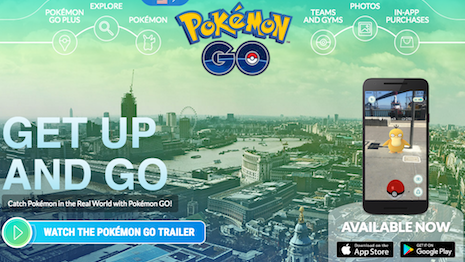By Joel Citron
On May 15, 2014, Google Glass became available to the public, promising to usher in a new era of augmented reality.
Shaped like a pair of standard eyeglasses that felt similar to a clunky headset, the hands-free, voice-controlled device projected information and images directly to the user’s eyes, augmenting their everyday visual experience.
To say it was a flop is a massive understatement.
Google had to contend with the legal repercussions over privacy and safety issues.
Consumers were reluctant to invest or wear the device for the same reasons.
By the following January, Google had already discontinued production and pulled the device off the market.
The idea of augmented reality has not fallen completely by the wayside, though.
Google has committed to a redesign of Glass, Microsoft is currently developing its own version known as the Microsoft HoloLens, and several other brands are currently developing similar devices.
Though the interest appears to be there, the idea of a person going about his or her daily life with a visual computer overlay has yet to be capitalized on in any meaningful way.
That is until Pokémon Go was released.
Glass half full
Within one week of the July 6, 2016 release, Pokémon Go became the most popular mobile application of all time.
Developer Niantic – a Google spinoff – successfully created a breezy, unencumbered augmented reality environment where virtual Pokémon were inserted into "real locations" around the world.
Players of all ages were encouraged to wander around trying to “catch ‘em all,” while occasionally walking into walls, entering dangerous neighborhoods, and causing traffic accidents.
While no one can argue the app’s success, should there not be a better way to interact with it? Do we really need to stare into our phone to find those hidden creatures?
I think there is potential for an even better experience, and it came and went two years ago.
I am, of course, referring to Google Glass.
Imagine playing Pokémon Go within the confines of an actual augmented reality. No more staring down into your smartphone while narrowly avoiding real-world obstacles.
With Glass, when there is a Pokémon to catch, it will appear right in front of you.
When you want to catch it, you can just hold up the companion smartwatch on your wrist and throw that Pokéball.
Sounds like a digital adventurer’s dream come true.
But if there is one lesson to be learned from Glass’ failure, it is that users will be reluctant to embrace anything with a less-than-stellar implementation, especially amid privacy and health concerns.
No matter how amazing or innovative a technology feels, unless it offers end users something they feel they need and not just a temporary distraction, it will not be adopted.
As expected, advertisers are clamoring to get a piece of the augmented reality action.
Catch it?
Instead of the annoying interruption of in-app marketing where app developers will not allow a user to continue playing until they view an ad, now advertisers can be a part of the game and actually improve the user experience.
Want to get more foot traffic to your store? Run a banner in Pokémon Go that when clicked will direct the user there and give them the chance to catch more Pokémon.
Such integration would change the user’s perception of in-game advertising from that of a minor nuisance to a welcome benefit.
The benefits of augmented reality are not just limited to gaming.
Snapchat, for example, is currently exploring the prospect of using image recognition to identify objects in your videos so that they can advertise those products to you at a later time.
New York has added Internet kiosks throughout that can identify users as they pass and deliver a personalized experience, showing them customized ads and potentially – with the utmost caution to protect a user’s individual privacy – engage with them by using the built-in camera in these kiosks.
With augmented reality apps, and the newfound willingness for users to allow themselves to be augmented, we are entering a new era in targeted advertising.
Search engine marketing and, in particular, Google’s keyword-based advertising system, allowed marketers to serve ads that had high relevance to what a user was actually searching.
Display marketing, while allowing the advertiser to serve up ads related to the content that the user is viewing, is ultimately a crapshoot. It is difficult to predict whether or not the user reading The New York Times travel section is really interested in booking a vacation specifically to the Bahamas.
The chances for success with such marketing are basically in line with taking out a print ad.
Programmatic display has helped to target users more precisely, but the fact remains we are shoving a sometimes-unwanted ad in someone’s face in the hopes that they find it interesting enough to click.
WITH GROWING user acceptance of augmented reality, we will be able to actually see where users are, what they are interested in, and create advertisements that they will deem a welcome part of their experience.
The potential for positively engaging end users with advertising has never been greater and, if done right, users may actually be happy to see them.
 Joel Citron is director of advertising technology at Ai Media Group
Joel Citron is director of advertising technology at Ai Media Group
Joel Citron is director of advertising technology at Ai Media Group, New York. Reach him at [email protected].
{"ct":"r1u2qJny0bLXvip\/FJE7k3o9K666rEntcYOCTGU2cfS\/dSgP2RFl5Q7uZMjWMglx1wx8CiQanaMLz\/QzKOl24YWMhkkia7CzpWZEWZ+kN\/LJ\/wBNstIYxqwQBMT5FGJfyzB+iUvWJ3wy4LtCtjPwRs1WCdJX5ZL6sD\/eNfhfw4CsLB8meUUXO0nva3CkVfJyO5M45HT384bSlAIfTcnc549uiUXUxOFpWlgKaPStZArMoGtJh220ukgxiTSWE5JQkenNn2NXRpwWPgbQNL9e8Gmgs1IILN+lG2hdhOPddL4M4E3IXveZf4F4mtzusQbcGXP\/lYWgO06svE2eGYqdWp6brHFfPsqfoYmTyQgR7\/m4V1JB4psgt81yZSwWLtfuqU8RuTq9GOT3nq2qgIOX43gfjwvcjwzppobPKgTTYzlRGn0d5pBmFgV+oM\/BFd5lATE9ivsUraVTCa\/lhFJjlCp8JtJkm5txAf6Ibmx9EslSGbjb5U7k02XFSj+6I6eAD6k1ERZKeQW1Iprptqn9IBoyGDHc3uQPs\/RLhP5Aa4K25FtY\/nSgrXhgyh9USPO\/Im7t0QwLcPfjG\/GIOBsLQeONUjeb+7nH5tx3E1bMa5BUF0TdJU7f6V1jRpQGX2PMPmLLcbn5kn4Ok5izqKttfvcAIQ5MLSnX74zN+MfmX5h+ziJJcMSLa0vaBm0APjvcCy\/nsIE9AEbjj6a30Zof\/8GG4e2sZnVDE53aOGERs1A08VGB9pfOeLE4vcUVjdsJxpVA8E+g3ifSEa4FxkfwkH8D6UiMw5v3hIdKm85rbXJTXlvm6KF2LXsNiN+29cTCDXKjwuXOEHuXa2MgFKpYCV8Vo2iL140OYeKR5eU0reug8qzsebSWIHK7FmZBsnypFtkDDWDZFjASESbRZIdntjxjI86Kqm7s5wIuNz2zWjOSS15bAbxSJApxa8br5AEpVHMXqaZOWhDn7ZtQK5\/VEuBidQxiYW+HBpEuEtY9uEUQP0yjwDuNEeCexl7UlnxldOr16UQzsyv8qhUz9aWa9pCyX7loF8TujuO5ANCS0jeaV\/ZOvi4+2oWPhnrh4MmajuF8x1MCF4nFYArvRhv6+pPNivM9HLLpMxJDmfdOj23zKvTb0JunSCnI5MIbsLP\/opbmwLa9qE0fYLljl7rCGSaMMdECU+uH8cQttC7sB0fHTxUGgWF+U4PquZM4cimt4aNBnziv2hympL6M1EhAYhpfzq13eCqc6Fs9iEwxGLcslcwkYPkVTvhzRVm0oJtU9qvUJqDKmehUJX3ripHQt2AEQlKWwq6UbI399RJPhJGzX1tSt699WPDnd1hKfbzSG5IGvnnZkvnj1yN6fTph+nDbcnYHQLjUeQuiab1qahR0lyOJEGmiGxsPf24RWoZAVOR1nIV\/JPK2S+dSsxFXZkssk8dMCoHHZnia\/ujtNQqbmdw4J\/X71qyA1rJE0t94Me7JkwGK8nMLIMks13I9C9+s\/1vtDB47T+G8GMDOsvOJ4VB3F1xnX3dGGM\/VdxO3oPy2+KS2SjWsMogbdHltsIduWGv67UW8Bd4q+XAcXChy7h9zn1fvMQWBkt86e5BtDpEUPSZJtwxlh9yIFM+286l\/vVuGbAYiS90P4JB7OOpIeWF0\/vNz0uE97etItNoOh3POM7Bc2S5hBMVMOURXV09ABCcbNKWrvhBhUqfguH8pmMiGon6DC3TKkHqQt9Q\/TcFc+77w7SSNhtXmqM5H15dqyoFPVMDM1tg5cNCNTG30HYYpHIymmO+OM8e+yAgXpf8KOeP1f6kUXSPxhHbBVZtdYaxEG6Y89+9mP\/3GssyiitIRt1bMFRdsdtYQ8mdlTjqAUDI8EGKhxapD1jXbUaE5aw\/j\/xDuNgupzdbTio7j7c+M1GhsAHFy1MXRDSV\/H75tN4oAYyXSzEYyid2+cdAIcj9Nc8kJr\/czhBJ8+gnfmFIfbr\/s+58YzfbB0rY+efF0R\/Z3oLPtiN0JyyohgozVGMmUw1DCUnoKjArzb\/Li0ZxtcFnJTDUoV8ZjmvFxpXtM+q9P+TZAKq\/A5MsrbzOtbJUgw1AtpZk99FL+E4HU8d627Lsf3yawhTgru1u9dl5xCmZTffrb5YRQ91oy3UydHWn\/7P8Id3DodIE0+fWD3HtC9pBSvYdbEYQQYLs8DYxseNPb6a\/PGAtXBnC8wEBhf+3P0IBjlmhXDQWeO+l61nBFa4z5qGNTlxqzl3F1LlJuUGgRfpkQC8Q1zsXftlD45wJspNPYiAPe\/Ub4rQ2efhEjINdyAHTX4E636HjMm8ulO5u9JCfOrp1Q0sQZPJHBKPPJFZUrYNBQn3tR\/OMAxTWNMc0sB8W71QWBXycRQryb1P\/iYBshP+QFLiMzILkLVyBivkh8CEWTAgA0L7fz54oKxyT1dCaWCBp\/fLRLMybCAD6c+1tE6eBNTXJM+cO4u5vVDIdmkols+dwh1ebgIOB5QzvLRR2v2wMz+ySJ+5tT5hUE++2z+WVHa8HI09rSp3Gd\/UkZmXBui+\/04XtiMyj5DxI9z2\/KExIdvzQ\/3u7kvLUUkItS0dvIwsMRAlibiHq1Neq8lni\/rgY+a+xWuSme++ofEp6uWE426vhEEHb2Ca8X14ojXI26EU6ZLuw4LR9wQbFEqlxA\/uZ6S+Nm\/94At8UCQGlVXUYikf231xkz5j89japXoFIZ1GJ\/El4xnhuKE+9ORIxtWcQmdkMvG8sklIQDdl33KZWrSsW+mG59sofsFngvVAX\/urpl\/gaXFxVuD13PJopptOB+WsK7F040o7OuvPkGBcVYup4UsF\/v5qa22crjw2tRYtWYRdMUvRBPt0sJ6ZoSbxHvTSYG6bdcj21w7SvEVL2jt9mSsc7HBAXLhUa6ostDVgPthpyJLCs1JIEmFazmEBNSgY32cgbzf6Qsqu9aOyz9geIHIL1CfRlqsXk+6Rk0YTuvdEZQ\/NOvDyTj3R+lVaxChGvwdJIkMG1Dt4+mVWE+xLD1hvd14FTFYxC+FpMJtSiVrYexfdIh5vvEL9y66tVQCLpY0miyiDZQF2zt\/ijcA0jm9AkeKNNgZYMWJ95BWwAsJOb8W9r1uQXAYO\/3OvbaCOEIBlpVhL1\/xgIxaJvOqMM0iqNJfXTYiHi5A9x\/HFqk57URqEO8fhhV2RnXiqlLzEnZudzdULnYWgMrcEJrMFonh3cQrftpAfr+zh02NZRY5AwzeHR3cwGOnWRpwP+kRLkuAfvAITAgvEpO+SuJIfiZ+aLqoMsorANui3KLJRGez5qXcOeV14K7BkyGjQyXmFJsK6yw8QugtwdLzzbIkgTyUFEbBYPpD2o7zyP15kVOt\/tdhaUkzajlS\/JFlPoTrxDfmScrgkEwcQjghKem\/kHN8V8XPJQxNiWXMM\/5J8WRIaA1Yn2Dp\/NakC17V9LoW+Iz2PW0l82LH4lQfrJTb2yYo04mlfMPO1nJVZdLoW8UnlmeIyklTds4xHyk4pYUoNNrOd09MDlYPniWbbu84aEe2mUFwtFo\/d3\/jmOGGvw2Qwlqd4P40QjaxhwtOxj75yVcQIuBkHb1PnjfR76Er10Xx1qWEObELXVaCoG6F3a8CqqpSnDkgekaf8ZRTP12GOpZRl+da5as7y1Z69xKFfpvTCB6X17HD6yev5LEllbIl3qZK2texSuB1sjTIgohYttOcJA+VNcm34KiEdxZEL359F6\/wQaSdnGtsfMpIugXgON9Y2YwT3D+2dNXyfRwvL\/JWOTduUxsKS4hy45f2BzH\/LpH+xzlPXywzl51Gza9kv4SN6sd+GKe5w4+KxhPXFjPhk2kKjv0ZRkNd+UiglxdqLHkcxuehPiVo\/32IqkELQhQbp0EVCIaWn5AhsH7W6yIMv+8XF8475f8OA23Fp51VoKT62b3EftQ77Oz6iL\/VAPcNMLTQZF7jNCc42LJo\/YUm3iJ4gnci2ZO2JTWhOZCbripdEgqVKcULcUXnmkM0UzRpqu08vuWdtsoh1nl9LkQp9jCwRHYAMzqX\/Jxcru9VBFbYVJI0X36cqoRrEiUTSIAPhipxmNnCn4mqgf\/C7xJe485dZ0RVT5Yne4mhe9Y4V47QagDt50OZeG9LrP2kWYYTNgxiTHgNIRCIWmTbtrPm1DzlGMpbt\/LR038c2CQnbj3zigvNS7YyCjD34628\/CzTqGPNh+n\/qAsqp5hOKxGW49NpOXjtnflnYokjXp2XC7ykhaI1DZkXzC8x0RvrewGI8RArWPE3IXgxmU1vxHtXjnvKNIYuf1Ffmy4YIqalRrIOZnpPeNGyodG7HWSyn+f5iSdKx5QumKt\/yOujydWqVz0RoRYzy00fFWeT6DH7n1loyJzRwM+yw5nLqVGow\/tvG9v2Wqm73FsS744JMihODvayB2JUptasRKvFPhBPtX82vLHeRBEa1ZtMp+plIGeU5NUhkMG+ncl21xUUG0uBzuf4IdZPrudtOx8jdR4njeenk6FbqNx97NAS1mf1SR9jut+6onlzjvMRLjaPjeVcru2G3n96hfvPsYi2Dg5LZEaUlzjhoY+D3VHKLK6e1UhIF3E\/e+fWaAYnrh7CDkmpdXe+olheUlCrKFA2gazF41VlrLOxhD+gUWXULpTFOvDED\/9\/F\/\/4FPq+7eYi2DofTFlNIDJ5cCgwpBMsu3AC6HPFpoWuzJMLJELVoIqSE+L6QxH\/tyGcYy3Kkd0\/aZf7XNdau42WAXup\/PqdFqbCkGeKfTWeZEpqTpQyuhJqwjmYu6lyblJUdRK49InZiigvFm7cPH5FV7dZz1PuzrLZuqS6rLCW2LXS+CvXy2\/AH59s\/rKoV9UY1GSHseT9KQGpcNQkwxPyuG39wgOHW6VaIvc\/T+b6F4JMiKiLojuUvS\/uj35y5nOHddOtRup50RZZnhdsWqurPb8iQaHUW\/q1cQlUO+UOQSC+V7XlglMT419boC0TFXcQ+sg8I0b797jTRVYtpSUcLc5vC2A6Fpx6hZsZzyQ0lZibWozDX9GzBF5eveuurxK5ySZXJAeVbIV1gJcq5hX\/bpcDoHmJC1lp+L4B45dArejOscTW36ERbiA7GE2kdBt4JdipqDtDrOndZAqBnT\/lQtCopfgpO9Vttf\/KdZCb9PMeH4OBTx6aKrdOzKL\/\/7JFzq4HsG9aNsJv3fIPTFhy4Hu1rB+EywCaTgZ93uZ\/lHovEywz28xxi8WfIW0S0gC130EzyaxAg7FO1dq5JMa0BxqKBO9Fz8Mjklu6Y8OKYg4BK8byH4wnS\/bcAD3gEql8kxd6MO66RlevbXZ5q5W67fG5mDJkExx3wmcj6rRU0oDqu9y8UtULN1e2IqBivDixWw5vOq674+f1V1WMvq6\/4OFDSPykYAvj2tm89MziOaFnOyawpZm3w5PCA+EBv1M9ChV4+aeqRI5M\/RGYnQ7cIrwGMePBg5ti1N1+r7bJWpuynFGRJdKGcHiUstE5hkxnMwM\/eYiqCR58iOp3PfqXnx4ZfiSIMpwa+eUxxEadVmeNpov6lGIEkOnmG581K7K\/cfPnBW2C0vC7V1Egpzzen1LV3H\/xlbgjsMVhUE7rr4HFlfYTvEnpDak7M4KVHNXMzES2E0\/3EPBtEEJSdVe9tpwxyAFTELozF7PUq5JjzI713T3VSP7AhIX+oibKEKT4vXUByXOM+7ibeFAYoMVHct4kGX6I2b26og0D4vyLBAHaE3j7yD0TNEVD9f6OBGpfRb5dLb09KAQanVp4+10AAYnEKEdOwulUh13v39b9qi9alf4fcbZhwIbZY3WpHPkIQjck4plT9YGxxL8qFkBzgqseU0rbKOYP5L90+geVhF3Edmzu0nMLW3dO8RIer66Xjdhzc1lah3qhTCgejwwawpJx0+mWitfgSYQS02O2+dErfZbAjxZ22iYydMIxdW+wCUHWsJDwb9OqDVZh9WBO8RUZTwnh\/TGsajJK9ZSL\/rn4kL9WcOI5yR5vNApS2y8eEmcOMuHxtgK6uzEcOFk\/mDlwf1apOJXysSmkRdPle84GpuYdYQHgduWvx1k1TX4n9sVUH9LOLzzae27AujLZDgTdn4yc8exKNOPWpgE+4zKvG3HNPWOhXUdSvXzK0Nihi+qywj3F4VICt2ooh5OSJT9a4tjvq2msegmJYMaq\/aUb6xFU\/VCPoH1+Z4Pi5WJIwt5Cam5mE9Qgq7jdtv2o2yxA4v1qC+rA0NyFVFaKS00C8tPQwV9ihF0wJYVDpCtvDjTMFrf4PVLDM3syfGV1VP3w27A7mmFz6TUDwy5LKfwqAtqM3oTyWXbyAUd5SiPFQBw1P+Bw77aXo3uftVwnSN+7Rwhq52WjT17F47qJUZ5VtujXvbxxU1ykm4bMdVG9xTVNQ\/W1FMLgamWDMQQTpp5OPmFS+RtV8TUHlGGHtbKmf0Zk4RrJvUf2CskDgLm4\/SXJ9Aaa5TT7G5WxBDNJazbjJRUZMpoNlfNjZdMBlBol\/+W8W5RCaf3\/wFyYBbP5399XcJXejhVXb8WUrUKs1DJ7u81vEYOm5KPGkmh6aIJyZkUTEESPvy88e0R52iZr022mxWjapq5d4muv8lef2mEmG9eY\/MrX3TggE\/m9MW7rKtEGWxg0scWQbt26JlyWX5t5uip610qwzgT7X4zXfM0kcPCwBbgDZtZjvSzGjr20LG8d01RSpovJwsQfKQ12uF1FxIGjDl8xXLCsOKPF2ccWUridc\/m9MUgc7AMRy84mDuM\/eXTd80mDiw+r2\/4NECN9WknMw7aHPuemE0e7NISFS\/y880y9JsuCb20IwoJ0Zzcnb1KmHJqiXhnG4hzeWh5rmOfnDDAS7qRdkY9JzwFLGQV6tHSg6uHv9EVQEGWC0AqOsaxv+7OEb4G9luHqhn2A2mp7HS\/FxJwiwwDzObxbTVgXaKT1KzRx+Kbo6tT46aZT0r\/D3i81L0oArBSLeUrOcfPaIPWJzItiHyglIPq8TKrNGQ6n6WPxkySII9\/Ilo+n9O8gDyqd2AWo5F7NQbwbHtvc8CYeJ8yCrvqOXllc85pAuH3qL5xg3hN0S+0GEMdgEdbjgO4bV6htjqhrpuOj0Htpym5tyNzVM8sJ\/A9nhK6Z9ZN67UiV41vsdeaSg6uWnRjfrRhxd5byXvttwfS\/ah0+6VVtpNvzKiCKim79Ba1\/7pMyHUiaaNcyRFRus86tdZmrb0uXUp4+PLxudyIWuudjRUh2qEdVQPWXht2fzVTdzLRwvrxHbrma8gyAvxMPNiT0dn3VVO3Cfza9CJJyxOJD1Dudc4cTO2yGJjsZ4s8K6KOSQKBfBLEGm93buiR9hXQTDQ\/w9Oh3YjK3+Z1NMTbgrjMWHqK5fXTy4yHU6PDB7quKmYdLaRc\/NBw7e3swxWKayvYwvFZqZkcR8LopHjkshhcUssk3bF7gQySIUrMc0MqT+G5nsqkXxRRbdgUFu00UCCYG9XnBponKh2bHviVtnW0C7zBRnhADq\/6SZxdpy6J\/YUF30XFhp\/ZL4d0h5Qa3nJKqhMnvr6XzlxBaMWwzBbFeRROxyhuUc6HZXnLjNY4VWIUD6E1AiDn7IbUeSPY2tNSHBi5CM9aDRvk4Zx4xv4BeVwHqL5NL0YcGaHfOkCnXCacN3fe7Ha6VDZXFyccnRVrQEEs6OcnTmh0KxzhN\/UnFZ8WUHZUYQy7YLL9wVdrklH4gR6LqCwLSxotzyQCmTJR63lSI0pvCAVqVCY8Q8JbF3O0JX9HtsUJwdkwhKTZW4ncndAJncEnOrRxpjMIsWeVoXrJhx2WYZAPNZPd1ceWirUkTAmyhF1VpLuPKKfwKP4x8PDxZjiqoggd9HIV9atJWvGrAOs9\/uCsixLWIY+OBEtSzskoiPllmRHU2FKF4k9gWJaAXLWVg6BzfVjNqWGyAsqWxpZfrI2kW3cJVVNquO7L9ccj7kZfdxsn0t0SfXGC02PjEkw0i3AokUyJyM1zJwDJpSHisYDyB6P1aoYhVNbk7QmVG10qbVSrUFrtU0QWstIRKDARm06ZU\/GL1mlLdIdyhGEQNomEE0Z47UXVER\/9aGBzKOn1166RHwVxKroCvq\/DfIpBYw23AenSr0IMa3TinaKQJjmQKqCoG4e7WVfduZT3kGfkOceIGQLrXMOEiKJSzGBLPszGb9QfteWnmLazGANAmzhNt\/SscZvWq8F1h9rTzuh+17FGcJR6TwXOaqTghY0v7NMq4a3KrX\/PtKcGMk6XDZjIxCkEFTgNgfRYNWXF4dXiQCIGMv8PJ4O8pcB6Tn13H91drUBOmV+a8iphZQBeYJTNPArd5XFNx5WtT7gpc53XZ6xz5nPTfH6Uu3PMhqahORkFq43QPXAh3qseTNZoc5RcLAsxZ\/gWRaFAtDm0n8fD58Q+DmiZFfp7+JlZfj331n7aVoqxlEfMOUiuu8KvEssq3wuy1GoxaU4LRCElwpxpTgh3AxcsJ27TtJ7iNW6BNraySXD7IURUI+GE1g78sBJg7FQ+oEGTslWNJonQ\/9V0PDferykbirmiQMELBREiHUz8CSYdUgJEP+pumVdS+OuYXGvFbjwL0iObLe8MvSqgBySCpBlf23bOK9tdDzfO3RRSmTl4xbi6Sr8L8XjbhhQC\/JuiHT6KC4Vm6cmv0o1CDPm0VL9tnWrgcylnnJV2E9WCEg+yuBDP7htDe2t\/B3G4D7SAPl2ITUHxVWQO\/1YOJ0KaiL0DbBYrPo+DrNsZVb0+Z0\/Mlum1VWFcn7qfuioc8pGnCKMGpMwB+jeVcqQ4Yk8GeEK2xIE+nGkB9a0LedNLyE1T6\/H7b3VTurHJN5ixp7RxKlQ=","iv":"a965135a1d03c5da0b9a10efb7830fc1","s":"c233c8880726b9d2"}

 Advertisers should get real
Advertisers should get real
 Joel Citron is director of advertising technology at Ai Media Group
Joel Citron is director of advertising technology at Ai Media Group